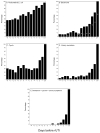Prospective cohort study of microbial and inflammatory events immediately preceding Escherichia coli recurrent urinary tract infection in women
- PMID: 19586416
- PMCID: PMC3674869
- DOI: 10.1086/600385
Prospective cohort study of microbial and inflammatory events immediately preceding Escherichia coli recurrent urinary tract infection in women
Abstract
Background: A prospective cohort study was conducted to characterize the temporal sequence of microbial and inflammatory events immediately preceding Escherichia coli recurrent urinary tract infection (rUTI).
Methods: Women with acute cystitis and a history of UTI within the previous year self-collected periurethral and urine samples daily and recorded measurements of urine leukocyte esterase, symptoms, and sexual intercourse daily for 3 months. rUTI strains were characterized by pulsed-field gel electrophoresis and genomic virulence profiling. Urinary cytokine levels were measured.
Results: There were 38 E. coli rUTIs in 29 of 104 women. The prevalence of periurethral rUTI strain carriage increased from 46% to 90% during the 14 days immediately preceding rUTI, with similar increases in same-strain bacteriuria (from 7% to 69%), leukocyte esterase (from 31% to 64%), and symptoms (from 3% to 43%), most notably 2-3 days before rUTI (P<.05 for all comparisons). Intercourse with periurethral carriage of the rUTI strain also increased before rUTI (P=.008). Recurrent UTIs preceded by bacteriuria, pyuria, and symptoms were caused by strains less likely to have P fimbriae than other rUTI strains (P=.002).
Conclusions: Among women with frequent rUTIs, the prevalences of periurethral rUTI strain carriage, bacteriuria, pyuria, and intercourse dramatically increase over the days preceding rUTI. A better understanding of the pathogenesis of rUTI will lead to better prevention strategies.
Conflict of interest statement
Potential conflicts of interest: none reported.
Figures



References
-
- Foxman B, Barlow R, D’arcy H, Gillespie B, Sobel JD. Urinary tract infection: self-reported incidence and associated costs. Ann Epidemiol. 2000;10:509–15. - PubMed
-
- Marsh FP, Murray M, Panchamia P. The relationship between bacterial cultures of the vaginal introitus and urinary infection. Br J Urol. 1972;44:368–75. - PubMed
-
- Stamey T. The role of introital enterobacteria in recurrent urinary infections. J Urol. 1973;109:467–72. - PubMed
Publication types
MeSH terms
Grants and funding
LinkOut - more resources
Full Text Sources
Medical

